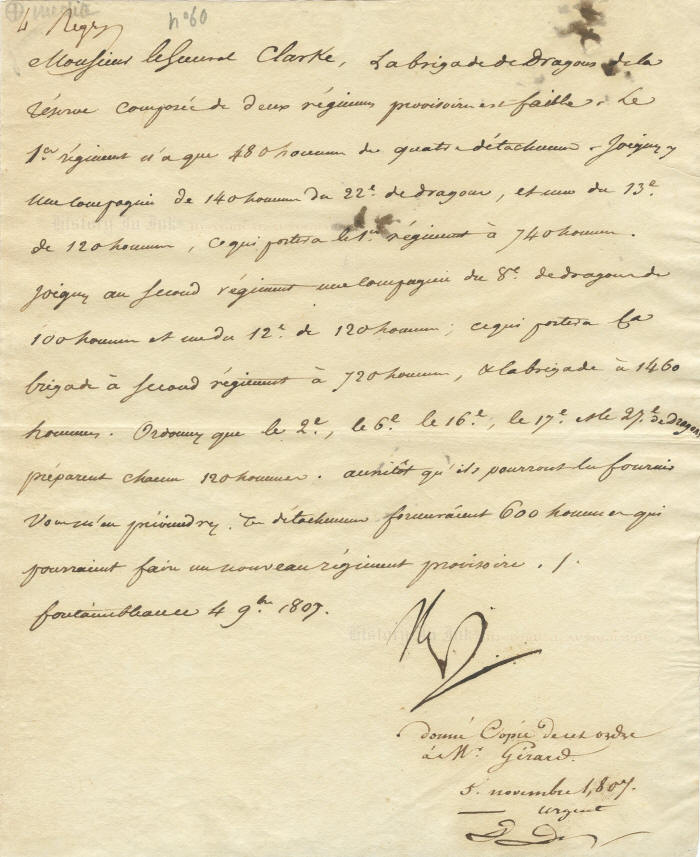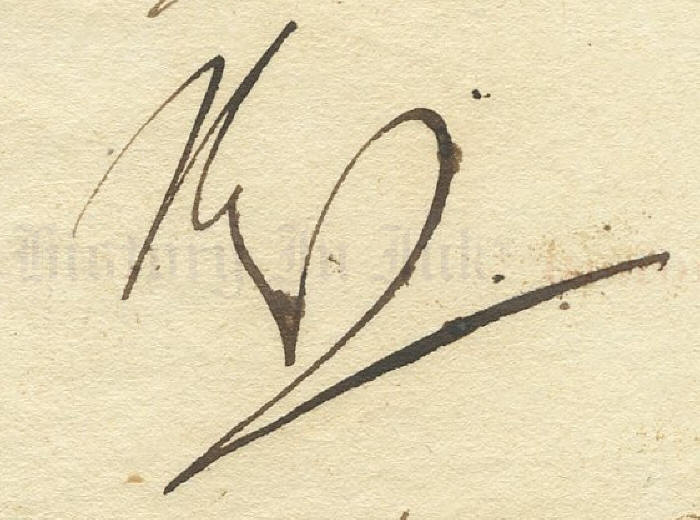

1408401
Napoleon Bonaparte
Napoleon sends an urgent letter to his Secretary of War
to reassign troops in view of his pending invasion of Portugal
Napoleon Bonaparte, 1769–1821. French military leader; Emperor Napoleon I of France. Manuscript Letter Signed, Nap, one page, 7¼" x 8¾", Fontainebleau, [France], September 4, 1807. In French, with translation.
This is an "urgent" letter in which Napoleon sets the board in preparation for his next military chess move. Writing to his Secretary of War, General Henri Jacques Guillaume Clarke, he directs the reassignment of troops in order to strengthen the 1st and 2d Regiments of dragoons before his planned invasion of Portugal. He writes, in full: “General Clarke, the reserve brigade of dragoons, composed of two provisional regiments, is weak. The 1st regiment has only 480 men in four detachments. Add to it a company of 140 men from the 22d dragoons and one from the 13th of 120 men, bringing the regiment to 740 men. Add to the second regiment a company of 100 men from the 8th dragoons and one of 120 men from the 12th dragoons, bringing this second regiment to 720 men and the brigade to 1460 men. Order the 2d, 6th, 16th, 17th and 27th dragoons to get ready 120 men each. As soon as they can furnish these let me know. These detachments will form 600 men who might make a new provisional regiment."
This letter bears a note at the bottom, possibly signed by Clarke, to “Give a copy of these orders / To Mr. Girard / 5 November 1807 / — urgent." “Mr. Girard" is likely General Jean-Baptiste Girard, who at the time was a General de Brigade, or brigadier general.
Napoleon undoubtedly was concerned with troop strength because of his plan to invade Portugal. He declared war against Portugal just over six weeks after he wrote this letter, on October 20, 1807. A week later, on October 27, Napoleon and Spanish King Charles IV signed the Treaty of Fontainebleau, which proposed to divide the Kingdom of Portugal and all of the Portuguese dominions between France and Spain.
Napoleonʼs dragoons were mounted infantry soldiers whose uniforms were characterized by trademark green coats, white breeches, neo-Grecian brass helmets with black horsehair, and tall black boots. The 1st Regiment coats had scarlet collars and turnbacks, and the 2d Regiment coats had green collars with scarlet turnbacks. The troops were equipped with dragoon muskets, which were longer than light cavalry carbines but shorter than the infantry muskets, with a bayonet; a long sword, for thrusting; and pistols. Militarily ambidextrous, under Napoleon's regulations they were trained to fight equally well as infantry foot soldiers and as cavalry. Originally foot soldiers mounted in order to facilitate movement, by the time of the Napoleonic Wars they were equally comfortable firing on foot and using their sabres on horseback. They served well either as light cavalry or as battle cavalry for charges. The French cavalry was likely the world's best trained. Alongside the light cavalry, the dragoons were perfect for service on the Iberian Peninsula.
The 1st Regiment was formed in 1656 for King Louis XIV and became the Royal Dragoons in 1688 and the 1st Regiment in 1791. The 2d Regiment was formed in 1635 and became the Conde Cavalry in 1646. During the Napoleonic Wars, the regiments took part in the campaigns of 1805–1807 in the 1st Dragoons Division of the Reserve Cavalry Corps. The 1st Regiment distinguished itself at the Battle of Wertingen on October 8, 1805, fighting both on foot and on horseback under General of Division Louis Klein to gain victory against the Austrians. At the Battle of Austerlitz, Napoleonʼs greatest military victory, where the French crushed and effectively ended the Third Coalition on December 2, 1805, the 1st Regiment defended the narrow pass at Telnitz, which traded hands between the French and the Allies before French artillery finally secured it.
In 1807, leading up to Napoleonʼs invasion of Portugal in October, the 1st Regiment fought in the bloody but inconclusive battle against the Russian Empire at the Battle of Eylau on February 7-8 before distinguishing itself in pursuit of the Russians at the Battle of Heilsberg on June 10 and, four days later, at the decisive Battle of Friedland, where the French routed the Russian army. The Treaties of Tilsit in July, which ended the War of the Fourth Coalition, released the dragoons in anticipation of the coming action against Portugal. For the next four years, from 1807 to 1811, the 1st and 2d Regiments served Napoleon in the war on the Iberian Peninsula—the Peninsular War.
There is evidence that in August 1807, Napoleon began preparing the army for service in Spain. Nevertheless, he set his immediate sights on Portugal because it continued to trade with Great Britain, despite Napoleonʼs edict that continental countries not do so, and because Great Britain often used the port of Lisbon in military operations against France. Napoleon thus wanted to seize Portugalʼs fleet. He formed the 1st Corps of the Gironde Army of Observation, under the command of Jean-Andoche Junot, on August 2, 1807. The 1st Regiment of dragoons was assigned to the cavalry division under General of Division François Étienne de Kellermann.
On August 12, the French and Spanish ambassadors demanded that Portugal declare war on Great Britain, seize all British trade in Portuguese ports, arrest all British subjects, and turn its navy over to France and Spain. Portuguese Prince Regent John of Braganza closed Portugalʼs ports and suspended diplomatic relations with Great Britain but took no further action, which Napoleon deemed insufficient. Thus, in October Junot's troops began their movement into Spain. By November, they moved into Portugal. They took Lisbon from the panicked Portuguese on November 30 without firing a shot, although in the meantime the Prince Regent had escaped.
But Napoleon had grander plans yet—which he did not foresee would bring his downfall. Although France and Spain began as allies seeking to divide Portugal and its possessions, France turned on Spain. The resulting conflict became all out war between France and the allied powers of Spain, Great Britain, and Portugal. By the time of that conflict, the dragoons guarded communication lines, escorted convoys, and fought—not only against the Spanish and British armies but also against Spaniard guerillas set on ambush and retaliation. Ultimately, the Sixth Coalition, a coalition of Spain, the United Kingdom, Portugal, Austria, Prussia, Russia, Sweden, and a number of German states, defeated France and drove Napoleon into exile on the island of Elba.
This letter is published in I Unpublished Correspondence of Napoleon I Preserved in the War Archives 700 (Louise Seymour Houghton tr. 1913).
Napoleon has boldly signed this letter with his large, typical “Nap" and has added a bold flourish. The word "Réglé,” or “Done,” is written at the upper left. The letter has one vertical and one horizontal fold, affecting the text but not Napoleon's signature; pencil notations in the upper left margin, affecting two words of text; and ink stains on the back bleeding through and affecting the upper left blank margin and three words of text at upper right in the fifth line of the text, both well removed from Napoleon's signature. Overall the piece is in fine condition.
This is an excellent content letter that belongs in the finest of Napoleon or military collections.
Unframed.
_____________
This item has been sold, but
click here to see other
World History items
that we are offering.



